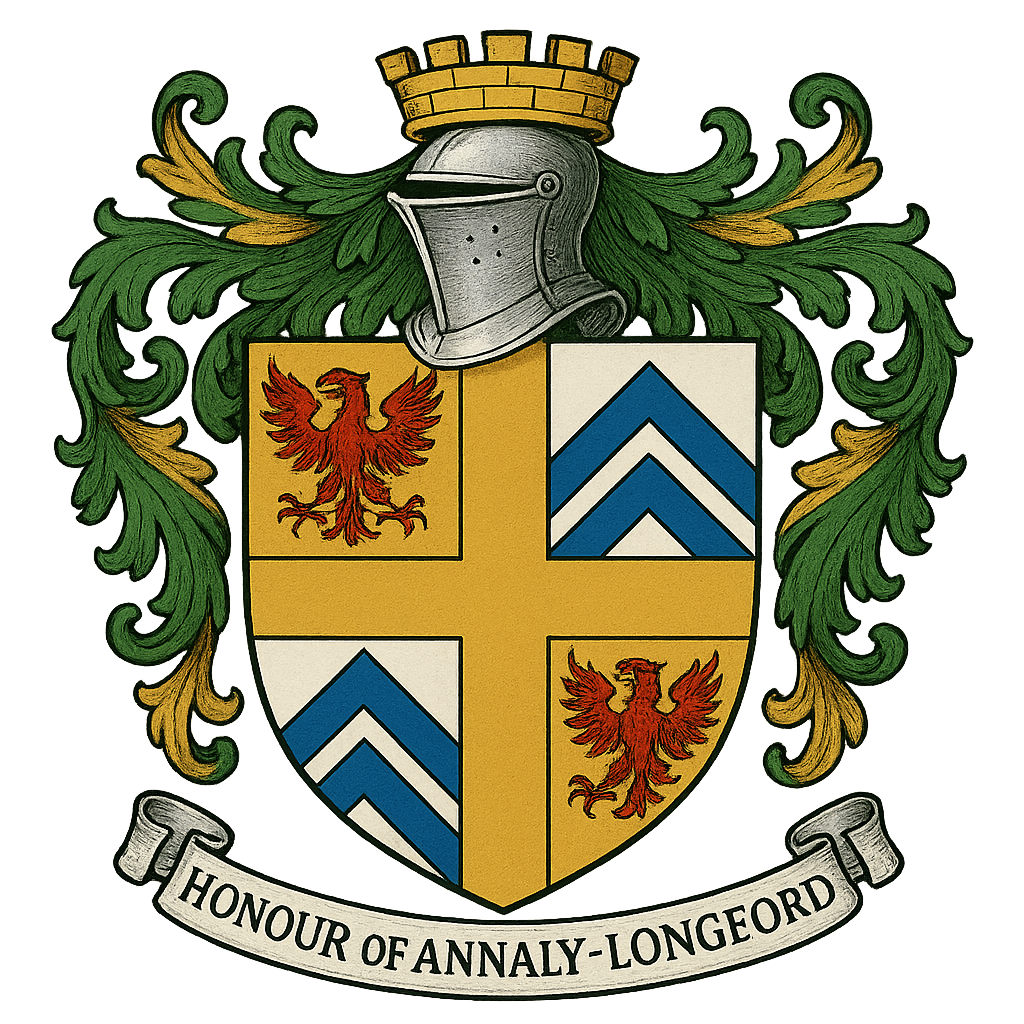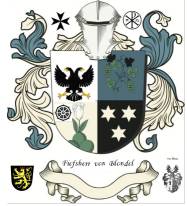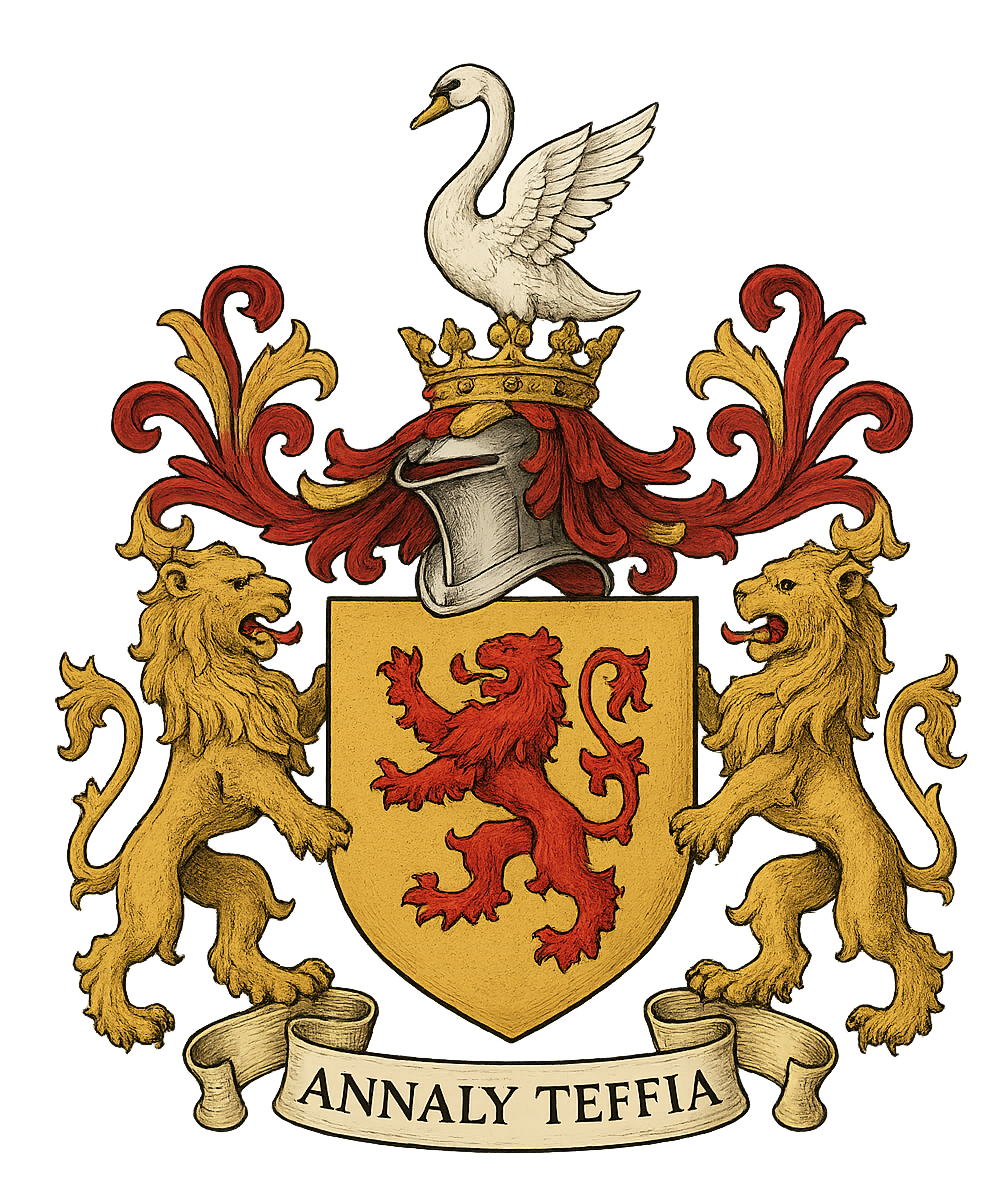Honour of Annaly - Feudal Principality & Seignory Est. 1172






|
Feudal Lord Baron of Leathrath or AbbeylaraFeudal Baron of Mainistir LeathrathaBlack Baron of LahraAncient Barony of MoyashelThe Abbey Lara in Longford was Granted forever in capite to Richard Nugent, royalties excepted in 1557 by the Crown, "Philip and Queen Mary". Baron of Leathrath (now called AbbeyLara in the parish of AbbeyLara ) This site and Abbey and lands were granted in Capite Forever to Baron Delvin during the reign of Philip and Mary. This was the seat of the Barony of Moyashel and Tuites in Longford at one time. Abbeylara (Irish Mainistir Leathratha) is a ancient small village in the eastern portion of County Longford, Ireland The Abbey Ruins are located about 3 kilometres East of Granard. The ancient Gaelic name, Mainistir Leathratha, means "Abbey of the half rath or little rath", and is derived from a monastery, the great Abby of Lerha, founded in 1205 by Richard Tuite, for Cistercian monks. The monastery was decommissioned after being granted forever "in capite" to Baron Delvin You can still see the ruins as you approach to the village. An ancient earthenwork, the Duncla (Irish Dún chlaí meaning "fortified ditch") or Black Pig Dyke, which runs from Lough Gowna to Lough Kinale, goes through the larger parish of Abbeylara, and passes about 1 kilometre north of the village.
1552 Grant of AbbeyLara to Baron Delvin Lord of Westmeath
before the separation of Longford from Westmeath - The Cistercian Abbey in 1552 To Richard Nugent Baron Delvin. The
AbbeyLara was founded in 1205 It is traditionally told that Richard Nugent, better known as the Black Baron of Bobsgrove near Mountnugent, gave this monastery its final death stroke. And the following extract gives a colour of truth to this tradition : —
4 Granges of Granard - four granges in Granarde, of the grange of Tonaghmore, of the grange of Rincolle, Cowldony, Clontrall, and Deraghe; the rectories of Dromloman, Ballmakier, Ballekillen, and Strade (Street), possessions of the late monastery of Larro, alias Granarde, near the town of Granarde, in the Annale O'Farrell's country. Citation
On many occasions this monastery was despoiled. First in 1066, when the original institution suffered in a dynastic dispute between the chieftains of Breffney, and again in 1272 when Hugh O'Connor, one of the Kings of Connaught, was at war with the English of the Pale. Two of its abbots became bishops of Clonmacnoise, one in 1398, and the other, John O'Mayle, in 1447. Mention is made of one of its abbots, Cornelius O'Ferral, in the Vatican Papers of Pope Innocent VIII. St. Patrick erected a church here and placed St. Guasacht over it; his feast is honoured on the 24th January. It is traditionally told that a labourer's cottage at the entrance of the village from Granard, covers the site of this ancient church, of which now nothing more is known. “At Lerha, in Longford (says O'Halloran), there was an abbey of Bernardines founded by Richard Tuite, an Englishman, Lord of Granard who died in an accident. The first monks of this abbey came from that of Our Lady, Dublin, of the Order of Clairvaux. Some say this house was founded in 1210. The founder was killed the following year at Athlone, by the falling of a tower, and was buried in Abbeylara.” Here also were buried many of the O'Farrells, Princes of Anghaile. Tuite came over to Ireland in the first invasion and settled at Granard. In 1199 he built the Castle of Granard,” to defend his territory against Ó Raballais (O'Reilly) of East Breffney.
Cistercian Abbey in Abbeylara Abbeylara (Irish: Mainistir Leathrátha, meaning 'abbey of the half rath or little rath') is a village in the easternmost portion of County Longford, Ireland, located about three kilometers east of Granard on the R396 regional road. Its name is derived from a monastery, the great Abbey of Lerha, founded in 1205 by Hiberno-Norman magnate, Risteárd de Tiúit, for Cistercian monks. https://en.wikipedia.org/wiki/Abbeylara Abbeylara first came into prominence in Irish ecclesiastical history when the Anglo-Normans founded a Cistercian abbey in the area around the beginning of the thirteenth century. At this time, the Cistercian monks were drawn from St. Mary's Abbey in Dublin rather than from the native Irish houses of the order. By the 15th century the abbey was held by the O'Farrell family. The last abbot was Richard O'Farrell who surrendered the monastery and its lands to Henry V111 who dissolved the abbey in 1540. http://www.megalithicireland.com/Abbeylara,%20Longford.html Abbots of Abbey Lara By the end of the fourteenth century, Abbeylara monastery and the surrounding country had come under the influence of the Irish rulers of Annaly, the O'Farrell family. From the appointment of Richard O'Farrell as abbot in 1411 to the dissolution of the abbey in 1540, all the abbots were Irishmen, most of them drawn from the ruling O'Farrell family. The last abbot to rule the monastery of Abbeylara was another Richard O'Farrell. He surrendered the abbey with its lands and possessions to Henry VII. The Abbey Lara in Longford was Granted forever in capite to Richard Nugent, royalties excepted in 1557 by the Crown, "Philip and Catholic Queen Mary". At the time of the Grant by the Catholic King and Queen of England to the Black Baron or Baron Delvin, the abbey held over 5,500 acres of land while the monastery buildings were in ruins. At this point in time, Abbeylara disappeared from Irish ecclesiastical history. https://www.askaboutireland.ie/aai-files/assets/libraries/longford-county-library/reading-room/physical-landscape/article-about-cistercian-abbey-in-abbeylara.pdf The Catholic Abbey of Lara held over 5,500 acres of land in the townlands of Abbeylara, Ballyboy, Cloonamore, Coolcraft, Cooldoney, Deragh, Kilibride, Renaghan, Rincoola and Toneymore. Besides, there were 400 acres at Lickbla, a farm near Ardagh and another at Ballemanna and probably other lands as well. It is also worthy of note that several advosdons patronages rectories and churches in Clonmacnois were appropriated to Abbeylara, which should mean that the abbey derived some income from them. After the dissolution Abbeylara it fades from vital Irish ecclesiastical history until recently when the abbot title and hereditaments may still belong to the County Longford branch of the Lord's of Delvin. There is a chalice still preserved in the museum of St. Mel's College, Longford, which bears an inscription in Latin, " John Gauneus, Abbot of Leathra Monastery and Vicar General of the Diocese 1627." The abbacy at the time cannot have been more than titular.
On the 30th of November, 1315, Edward Bruce burned the old town of Granard; on that day month, according to tradition, he plundered this monastery and made it winter quarters for a short period. The monks fled to Athlone, but returned the following Spring, when Bruce had departed. Richard O'Farrell, who became bishop of Ardagh, surrendered this abbey about 1541. Its possessions were very large, Tuite having enriched it with 18 cartrons of land, or about 1440 acres, perhaps more. The following record which I take from the Monasticon Hibernicum, will show that Abbeylara was an institution of great wealth and influence:“On the surrender of the abbey, the said Richard was seized of two carucates of land with their appurtenances in Clonmore, of the yearly value, besides reprises, of 13s. 4d.; four carucates in Lerha, of the yearly value, besides reprises, of 26s. 8d.; two carucates in Clonecryawe, of the yearly value, besides reprises, of 13s. 4d.; two carucates in Tonaghmore, of the yearly value, besides reprises, of 13s. 4d.; four carucates in Monktown, value, besides reprises, 26s. 8d., and the tithes of corn of the rectory of Monktown of the yearly value, besides reprises, of 40s.; also of a moiety of tithes of the rectory of Granard, of the yearly value, besides reprises, of 26s. 8d., a moiety of the tithes of the rectory of Drumloman, of the yearly value, besides reprises, of 13s. 4d.; and a moiety of the tithes of the rectory of Ballymachivy, of the yearly value of Ios. The rectories of Athlone, Levanaghan, Clonmacnoise, Tessauran, Ballyloughlo, and Reynagh, were all appropriated to this abbey.” “Lease under commission. Dublin, 26 September, IX of Elizabeth, to Sir Thos. Cusacke, Knt., and lady Jenett Sarcefeld his wife, the tithes of Ballenamanaghe in the Annale, of the lands of lord MacGennor in the Annale (these lands lay to the west of Lough Gowna), of the lands of Mount Carbré, of the lands held by the heirs of Morff O'Ferrall, of all the Maghirt of Granarde, of four granges in Granarde, of the grange of Tonaghmore, of the grange of Rincolle, Cowldony, Clontrall, and Deraghe; the rectories of Dromloman, Ballmakier, Ballekillen, and Strade (Street), possessions of the late monastery of Larro, alias Granarde, near the town of Granarde, in the Annale O'Farrell's country. £13 18s. 6d. for the possessions of the monastery of Granarde, provided they shall not alien their interest without licence of the deputy under the great seal, nor let to anyone unless they are English by both parents, and shall not levy coyn, livery, or other unlawful impositions —consideration 20 morks.”—Fiants of Elizabeth. It is traditionally told that Richard Nugent, better known as the Black Baron of Bobsgrove near Mountnugent, gave this monastery its final death stroke. And the following extract gives a colour of truth to this tradition : “IV. and V. Philip and Mary. This monastery (Abbeylara) situated in Le Annaly and the lands of Tonaghmore, Raicola," Cowldony, Cloncrawe, Derraghe and Bellamane! alias Ballymanaghe in Le Annaly, with two cartrons of land in Lickebla, parcel of the possessions of the said monastery, were granted for ever in capite to Richard Nugent, royalties excepted.” –Monasticon Hiber.
* “Where a large mote still retaining traces of a shell keep on the top, marks the site.”-J. R. S. Antigr. Titles Honors of Abbeys – The Abbot and Orders Titles and honors associated with an abbey can vary depending on its history, significance, and the religious order to which it belongs. Here are some common titles and honors: 1. Abbey: The main title associated with the institution itself. An abbey is typically a complex of buildings comprising a monastery or convent, centered around the church where religious services are conducted. 2. Abbot/Abbess : The spiritual leader of an abbey is called an abbot if male or an abbess if female. They are responsible for the governance of the abbey and the spiritual well-being of its members. 3. Monastic Orders: Some abbeys belong to specific monastic orders, such as the Benedictines, Cistercians, or Trappists. The affiliation with a particular order may confer additional titles or distinctions. 4. Papal Recognition: Particularly significant abbeys may receive recognition or special status from the Pope or the Vatican, such as being designated as a basilica or receiving papal privileges. 5. Royal Patrons: Throughout history, many abbeys have enjoyed the patronage of royalty or nobility. This patronage could come with additional honors, such as royal charters, endowments, or exemptions from certain taxes or obligations. 6. Historical Significance: Abbeys with a long and storied history may be designated as historical landmarks or heritage sites by governmental or non-governmental organizations. This recognition can come with preservation efforts and increased tourism. 7. Cultural Contributions: Some abbeys have made significant cultural contributions through art, music, literature, or scholarship. This can lead to honors such as being recognized as centers of cultural heritage or receiving awards for their contributions to the arts and sciences. 8. Educational Institutions: Certain abbeys have established schools, universities, or other educational institutions. These institutions may have their own honors and titles associated with academic achievements or contributions to education. These titles and honors reflect the diverse roles that abbeys have played throughout history, encompassing spiritual, cultural, educational, and social dimensions.
|
About Longford Feudal Prince House of Annaly Teffia Rarest of All Noble Grants in European History Statutory Declaration by Earl Westmeath Kingdoms of County Longford Pedigree of Longford Annaly What is the Honor of Annaly The Seigneur Lords Paramount Ireland Market & Fair Chief of The Annaly Lord Governor of Annaly Prince of Annaly Tuath Principality Feudal Kingdom Irish Princes before English Dukes & Barons Fons Honorum Seats of the Kingdoms Clans of Longford Region History Chronology of Annaly Longford Hereditaments Captainship of Ireland Princes of Longford News 850 Years Irish Free State 1172-1916 Feudal Princes 1556 Habsburg Grant and Princely Title Landesherrschaft King Edward VI - Grant of Annaly Granard Spritual Rights of Honour of Annaly Principality of Cairbre-Gabhra House of Annaly Teffia 1400 Years Old Count of the Palatine of Meath Irish Property Law Manors Castles and Church Lands A Barony Explained Moiety of Barony of Delvin Spiritual & Temporal Islands of The Honour of Annaly Longford Blood Dynastic Water Rights Annaly Writs to Parliament Irish Nobility Law Moiety of Ardagh Dual Grant from King Philip of Spain Rights of Lords & Barons Princes of Annaly Pedigree Abbeys of Longford Styles and Dignities Ireland Feudal Titles Versus France & Germany Austria Sovereign Title Succession Mediatized Prince of Ireland Grants to Delvin Lord of St. Brigit's Longford Abbey Est. 1578 Feudal Barons Water & Fishing Rights Ancient Castles and Ruins Abbey Lara Honorifics and Designations Kingdom of Meath Feudal Westmeath Seneschal of Meath Lord of the Pale Irish Gods The Feudal System Baron Delvin Kings of Hy Niall Colmanians Irish Kingdoms Order of St. Columba Chief Captain Kings Forces Commissioners of the Peace Tenures Abolition Act 1662 - Rights to Sit in Parliament Contact Law of Ireland List of Townlands of Longford Annaly English Pale Court Barons Lordships of Granard Irish Feudal Law Datuk Seri Baliwick of Ennerdale Moneylagen Lord Baron Longford Baron de Delvyn Longford Map Lord Baron of Delvin Baron of Temple-Michael Baron of Annaly Kingdom Annaly Lord Conmaicne Baron Annaly Order of Saint Patrick Baron Lerha Granard Baron AbbeyLara Baronies of Longford Princes of Conmhaícne Angaile or Muintir Angaile Baron Lisnanagh or Lissaghanedan Baron Moyashel Baron Rathline Baron Inchcleraun HOLY ISLAND Quaker Island Longoford CO Abbey of All Saints Kingdom of Uí Maine Baron Dungannon Baron Monilagan - Babington Lord Liserdawle Castle Baron Columbkille Kingdom of Breifne or Breny Baron Kilthorne Baron Granarde Count of Killasonna Baron Skryne Baron Cairbre-Gabhra AbbeyShrule Events Castle Site Map Disclaimer Irish Property Rights Indigeneous Clans Dictionary Maps Honorable Colonel Mentz Valuation of Principality & Barony of Annaly Longford“The Princely House of Annaly–Teffia is a territorial and dynastic house of approximately 1,500 years’ antiquity, originating in the Gaelic kingship of Teffia and preserved through the continuous identity, property law, international law, and inheritance of its lands, irrespective of changes in political sovereignty.”
Feudal Baron of Longford Annaly - Baron Longford Delvin Lord Baron &
Freiherr of Longford Annaly Feudal Barony Principality Count Kingdom of Meath - Feudal Lord of the Fief
Blondel of the Nordic Channel Islands Guernsey Est. 1179 George Mentz
Bio -
George Mentz Noble Title -
George Mentz Ambassador - Order of the Genet
Knighthood Feudalherr - Fief Blondel von der Nordischen
Insel Guernsey Est. 1179 * New York Gazette ®
- Magazine of Wall Street - George
Mentz - George
Mentz - Aspen Commission - Ennerdale - Stoborough - ESG
Commission - Ethnic Lives Matter
- Chartered Financial Manager -
George Mentz
Economist -
George Mentz Ambassador -
George Mentz - George Mentz Celebrity -
George Mentz Speaker - George Mentz Audio Books - George Mentz Courses - George Mentz Celebrity Speaker Wealth
Management -
Counselor George Mentz Esq. - Seigneur Feif Blondel - Lord Baron
Longford Annaly Westmeath
www.BaronLongford.com * www.FiefBlondel.com |





Commissioner George Mentz - George
Mentz Law Professor - George
Mentz Economist
George Mentz News -
George Mentz Illuminati Historian -
George Mentz Net Worth
The Globe and Mail George Mentz
Get Certifications in Finance and Banking to Have Career Growth | AP News

